A Dynamic Spatiotemporal Analysis Model for Traffic Incident Influence Prediction on Urban Road Networks
Abstract
:1. Introduction
2. Dynamic Prediction Model for the Spatiotemporal Influence of Traffic Incidents
2.1. Input of Incident Prediction Model
2.2. Shockwave Generation Related with Traffic Incidents
2.3. Incident Influence Prediction Model
2.3.1. Derivation of Shockwave Superposition
2.3.2. Prediction Model for Straight Roads
- The incoming moment of the first shockwave on the upstream road section.
- The interval of the two concentration waves on the upstream road section.
- The interval of the concentration and startup wave on the upstream road section.
2.3.3. Prediction Model for Road Networks
3. Case Study
3.1. Case Data
3.2. Incident Influence Prediction and Accuracy Evaluation
3.2.1. Incident Influence Prediction Result
3.2.2. Accuracy Evaluation
3.2.3. Computational Efficiency Evaluation
4. Conclusions and Future Work
Acknowledgments
Author Contributions
Conflicts of Interest
References
- Chou, C. Understanding the Impact of Incidents and Incident Management Programs on Freeway Mobility and Safety; University of Maryland: College Park, MD, USA, 2010. [Google Scholar]
- Pan, B.; Demiryurek, U.; Gupta, C.; Shahabi, C. Forecasting spatiotemporal impact of traffic incidents for next-generation navigation systems. Knowl. Inf. Syst. 2015, 45, 75–104. [Google Scholar] [CrossRef]
- Miller, M.; Gupta, C. Mining traffic incidents to forecast impact. In Proceedings of the ACM SIGKDD International Workshop on Urban Computing, Beijing, China, 12–16 August 2012; pp. 33–40. [Google Scholar]
- Xu, J.; Deng, D.; Demiryurek, U.; Shahabi, C.; van der Schaar, M. Mining the situation: Spatiotemporal traffic prediction with big data. IEEE J. Sel. Top. Signal Process. 2015, 9, 702–715. [Google Scholar] [CrossRef]
- Goodchild, M.F. GIS and Transportation: Status and Challenges. Geoinformatica 2000, 4, 127–139. [Google Scholar] [CrossRef]
- Peng, G.; Sun, Y. Study on Urban Traffic Incident GIS-T Data Model. In Proceedings of the International Workshop on Education Technology and Training, 2008. and 2008 International Workshop on Geoscience and Remote Sensing, Shanghai, China, 21–22 December 2008; pp. 149–152. [Google Scholar]
- Chen, S.; Tan, J.; Claramunt, C.; Ray, C. Multi-scale and multi-modal GIS-T data model. J. Transp. Geogr. 2011, 19, 147–161. [Google Scholar] [CrossRef]
- Chang, L.; Chen, W. Data mining of tree-based models to analyze freeway accident frequency. J. Saf. Res. 2005, 36, 365–375. [Google Scholar] [CrossRef] [PubMed]
- Kundakci, E.; Tuydesyaman, H. Understanding the Distribution of Traffic Accident Hot Spots in Urban Regions. In Proceedings of the Transportation Research Board 93rd Annual Meeting, Washington, DC, USA, 12–16 January 2014. [Google Scholar]
- Appert, M.; Laurent, C. Measuring urban road network vulnerability using graph theory: The case of Montpellier’s road network. J. Rural Probl. 2007, 47, 66–71. [Google Scholar]
- Pollak, K.; Peled, A.; Hakkert, S. Geo-Based Statistical Models for Vulnerability Prediction of Highway Network Segments. ISPRS Int. J. Geo-Inf. 2014, 3, 619–637. [Google Scholar] [CrossRef]
- Anbaroglu, B.; Heydecker, B.; Cheng, T. Spatio-temporal clustering for non-recurrent traffic congestion detection on urban road networks. Transp. Res. Part C Emerg. Technol. 2014, 48, 47–65. [Google Scholar] [CrossRef]
- Wu, H.; Liu, C.; Wang, J.; Yao, L.; Zhang, S.; Li, Y.; Li, Z.; Liu, C.; Fang, S. ATSSS: An Active Traffic Safety Service System in Pudong New District, Shanghai, China. In Progress in Location-Based Services 2014; Springer: Berlin, Germany, 2015; pp. 239–253. [Google Scholar]
- Roberg-Orenstein, P.; Abbess, C.; Wright, C. Traffic jam simulation. J. Maps 2007, 3, 107–121. [Google Scholar] [CrossRef]
- Long, J.; Gao, Z.; Zhao, X.; Lian, A.; Orenstein, P. Urban traffic jam simulation based on the cell transmission model. Netw. Spat. Econ. 2011, 11, 43–64. [Google Scholar] [CrossRef]
- Brackstone, M.; Mcdonald, M. Car-following: A historical review. Transp. Res. Part F Traffic Psychol. Behav. 1999, 2, 181–196. [Google Scholar] [CrossRef]
- Lighthill, M.J.; Whitham, G.B. On kinematic waves. II. A theory of traffic flow on long crowded roads. In Proceedings of the Royal Society of London A: Mathematical, Physical and Engineering Sciences; The Royal Society: London, UK, 1955; pp. 317–345. [Google Scholar]
- Zhou, X.; Taylor, J. DTALite: A queue-based mesoscopic traffic simulator for fast model evaluation and calibration. Cogent Eng. 2014, 1, 961345. [Google Scholar] [CrossRef]
- Qu, Y.; Zhou, X. Large-scale dynamic transportation network simulation: A space-time-event parallel computing approach. Transp. Res. Part Emerg. Technol. 2017, 75, 1–16. [Google Scholar] [CrossRef]
- Imprialou, M.M.; Orfanou, F.P.; Vlahogianni, E.I.; Karlaftis, M.G. Methods for Defining Spatiotemporal Influence Areas and Secondary Incident Detection in Freeways. J. Transp. Eng. 2014, 140, 70–80. [Google Scholar] [CrossRef]
- Park, H.; Haghani, A. Real-time prediction of secondary incident occurrences using vehicle probe data. Transp. Res. Part C Emerg. Technol. 2016, 70, 69–85. [Google Scholar] [CrossRef]
- Demiroluk, S.; Ozbay, K. Adaptive learning in bayesian networks for incident duration prediction. Transp. Res. Rec. J. Transp. Res. Board 2014, 2460, 77–85. [Google Scholar] [CrossRef]
- Chung, Y.; Recker, W.W. A Methodological Approach for Estimating Temporal and Spatial Extent of Delays Caused by Freeway Accidents. IEEE Trans. Intell. Transp. 2012, 13, 1454–1461. [Google Scholar] [CrossRef]
- Chung, Y.; Recker, W.W. Frailty Models for the Estimation of Spatiotemporally Maximum Congested Impact Information on Freeway Accidents. IEEE Trans. Intell. Transp. 2015, 16, 2104–2112. [Google Scholar] [CrossRef]
- Khattak, A.; Wang, X.; Zhang, H. Incident management integration tool: Dynamically predicting incident durations, secondary incident occurrence and incident delays. IET Intell. Transp. Syst. 2012, 6, 204–214. [Google Scholar] [CrossRef]
- Sarker, A.A.; Naimi, A.; Mishra, S.; Golias, M.M.; Freeze, P.B. Development of a Secondary Crash Identification Algorithm and occurrence pattern determination in large scale multi-facility transportation network. Transp. Res. Part C Emerg. Technol. 2015, 60, 142–160. [Google Scholar] [CrossRef]
- Shaw, S. Geographic information systems for transportation: From a static past to a dynamic future. Ann. GIS 2010, 16, 129–140. [Google Scholar] [CrossRef]
- Loidl, M.; Wallentin, G.; Cyganski, R.; Graser, A.; Scholz, J.; Haslauer, E. GIS and Transport Modeling—Strengthening the Spatial Perspective. ISPRS Int. J. Geo-Inf. 2016, 5, 84. [Google Scholar] [CrossRef]
- Kunzler, M.; Udd, E.; Taylor, T.; Kunzler, W. Traffic monitoring using fiber optic grating sensors on the I-84 freeway and future uses in WIM. In Proceedings of the International Society for Optics and Photonics, Troutdale, OR, USA, 20 November 2003; pp. 122–127. [Google Scholar]
- Wada, K.; Ohata, T.; Kobayashi, K.; Kuwahara, M. Traffic Measurements on Signalized Arterials from Vehicle Trajectories. Interdiscip. Inf. Sci. 2015, 21, 77–85. [Google Scholar] [CrossRef]
- Logghe, S.; Immers, L.H. Multi-class kinematic wave theory of traffic flow. Transp. Res. Part B Methodol. 2008, 42, 523–541. [Google Scholar] [CrossRef]
- Newell, G.F. A simplified theory of kinematic waves in highway traffic, part II: Queueing at freeway bottlenecks. Transp. Res. Part B Methodol. 1993, 27, 289–303. [Google Scholar] [CrossRef]
- Helbing, D. Fundamentals of Traffic Flow. Phys. Rev. E Stat. Phys. Plasmas Fluid. Relat. Interdiscip. Top. 1998, 55, 3735–3738. [Google Scholar] [CrossRef]
- Jabari, S.E.; Zheng, J.; Liu, H.X. A probabilistic stationary speed–density relation based on Newell’s simplified car-following model. Transp. Res. Part B Methodol. 2014, 68, 205–223. [Google Scholar] [CrossRef]
- Wright, C.; Roberg, P. The conceptual structure of traffic jams. Transp. Polic. 1998, 5, 23–35. [Google Scholar] [CrossRef]
- Zlatkovic, M.; Zhou, X. Integration of signal timing estimation model and dynamic traffic assignment in feedback loops: System design and case study. J. Adv. Transp. 2015, 49, 683–699. [Google Scholar] [CrossRef]
- Chandler, B.E.; Myers, M.C.; Atkinson, J.E.; Bryer, T.E.; Retting, R.; Smithline, J.; Trim, J.; Wojtkiewicz, P.; Thomas, G.B.; Venglar, S.P.; et al. Signalized Intersections Informational Guide; FHWA-SA-13-027; U.S. Department of Transportation: Washington, DC, USA, 2013.
- Zhou, M.; Sisiopiku, V. Relationship between Volume-to-Capacity Ratios and Accident Rates. Transp. Res. Rec. J. Transp. Res. Board 1997, 1581, 47–52. [Google Scholar] [CrossRef]
- PTV AG. VISSIM 5.40: User Manual; PTV Group: Karlsruhe, Germany, 2011. [Google Scholar]
- Wiedemann, R. Simulation des Straßenverkehrsflusses; Institut für Verkehrswesen der Universität Karlsruhe: Karlsruhe, Germany, 1974. [Google Scholar]
- Yang, H.; Han, S.; Chen, X. Parameter calibration and application for the Vissim simulation model. Urban Transp. China 2006, 06, 22–25. [Google Scholar]
- Gomes, G.; May, A.; Horowitz, R. Congested freeway microsimulation model using VISSIM. Transp. Res. Rec. J. Transp. Res. Board 2004, 1876, 71–81. [Google Scholar] [CrossRef]
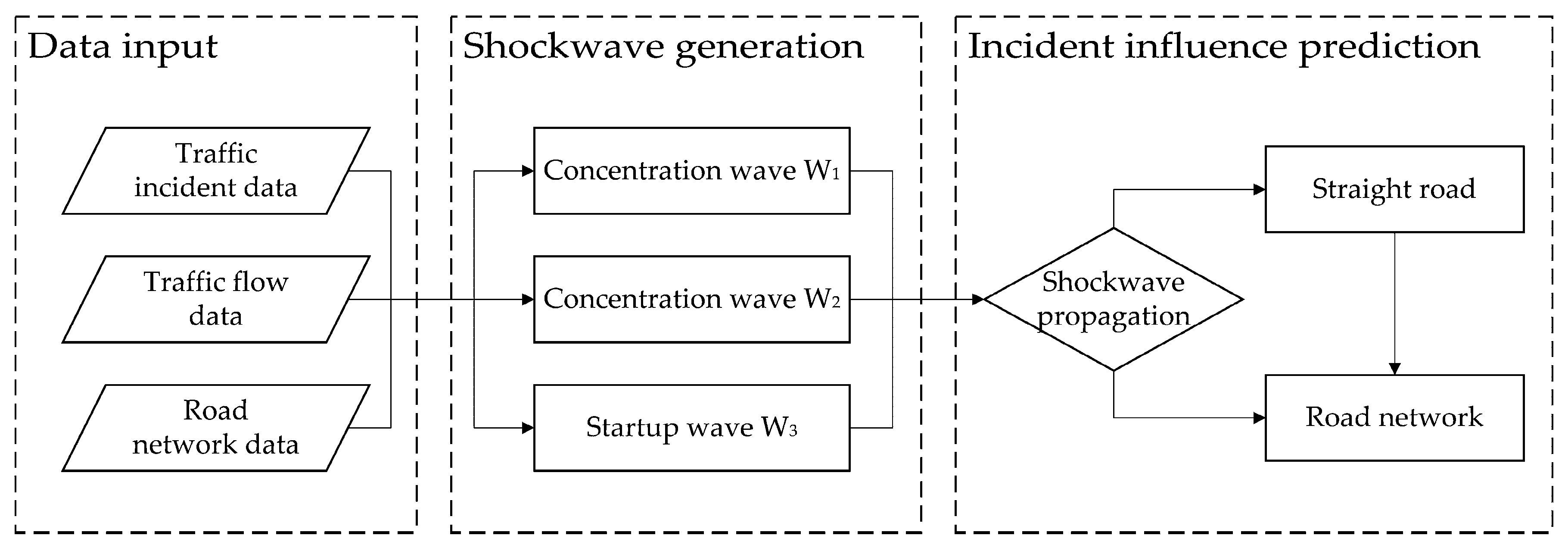
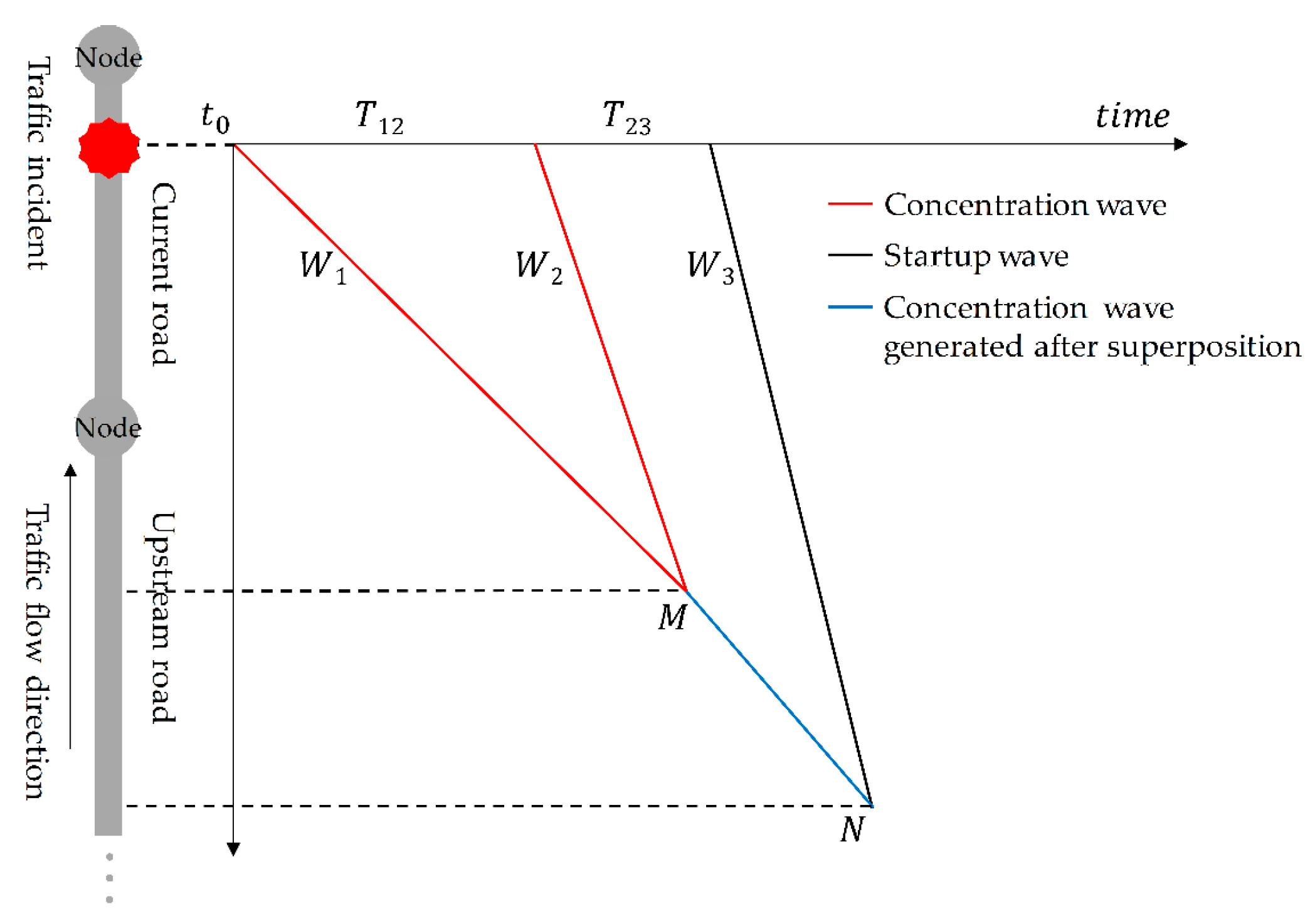
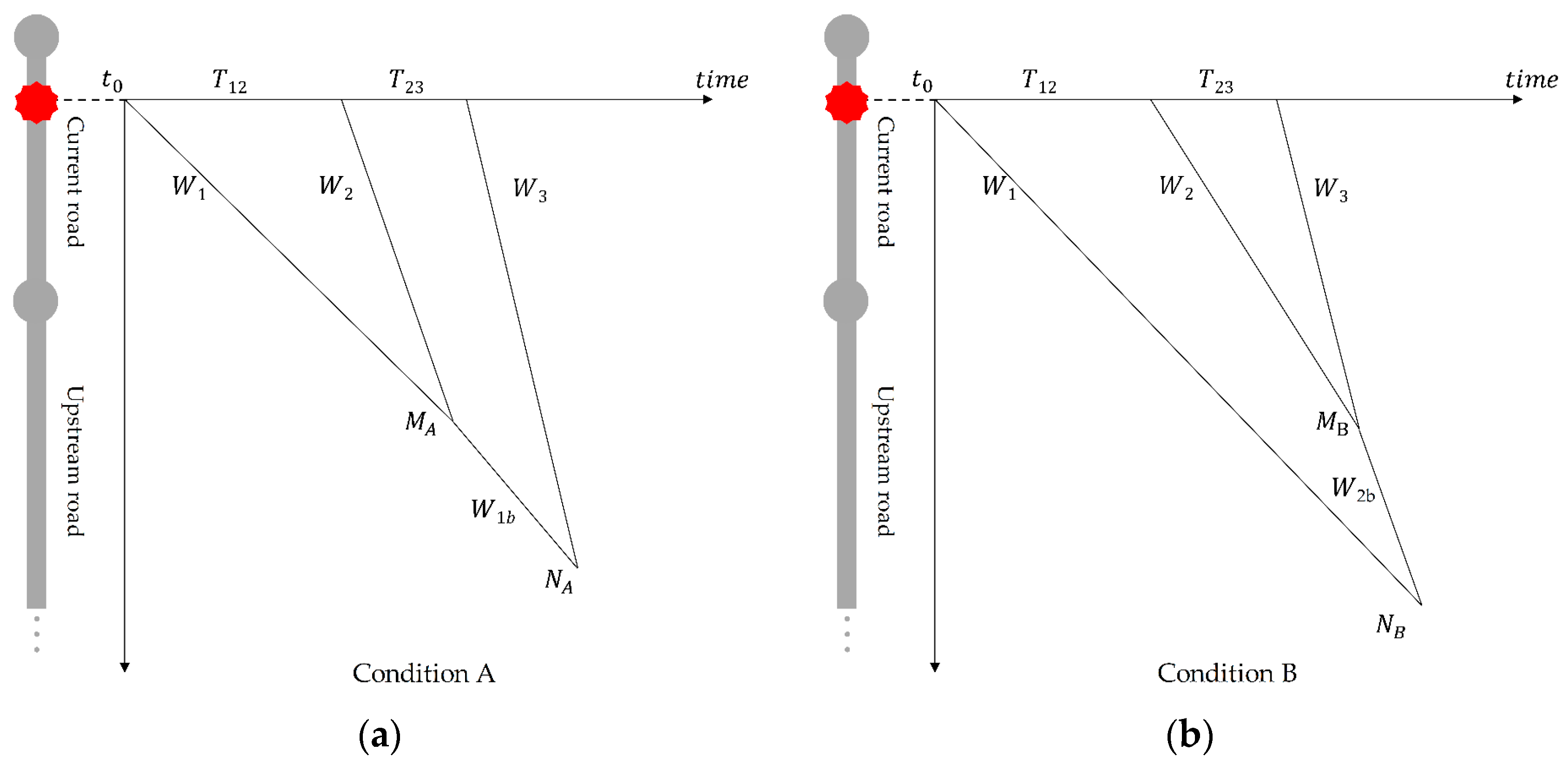
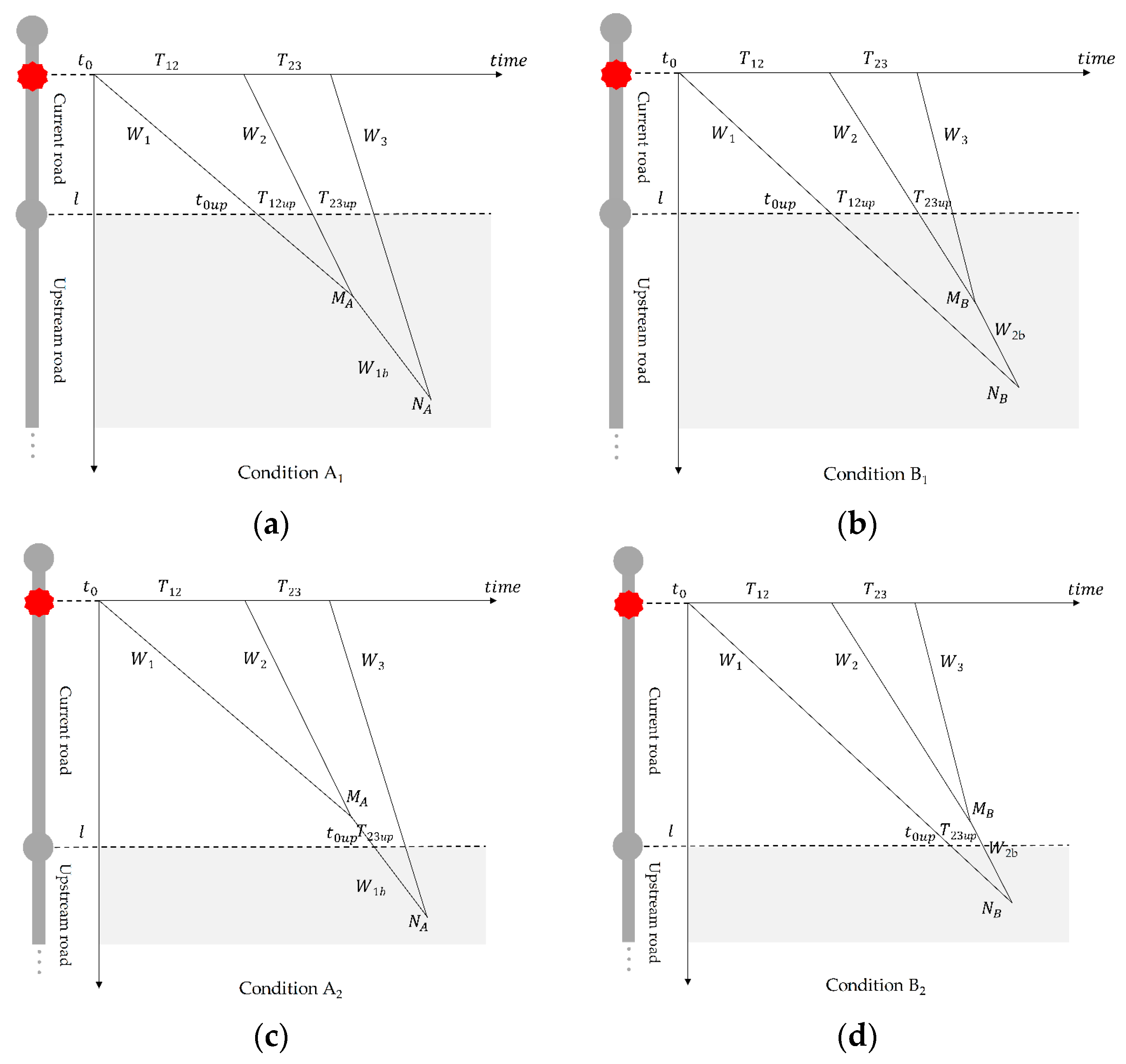
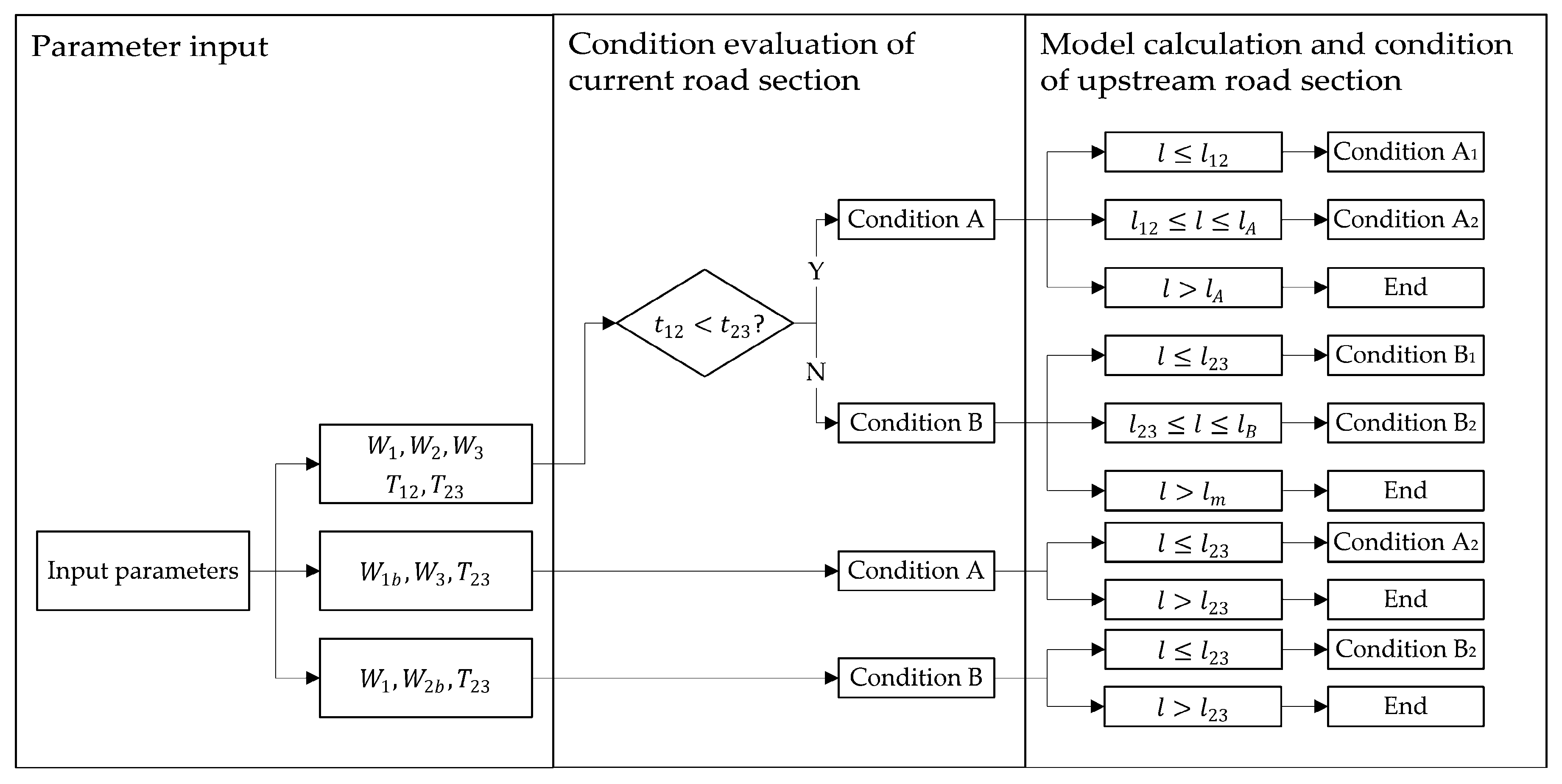
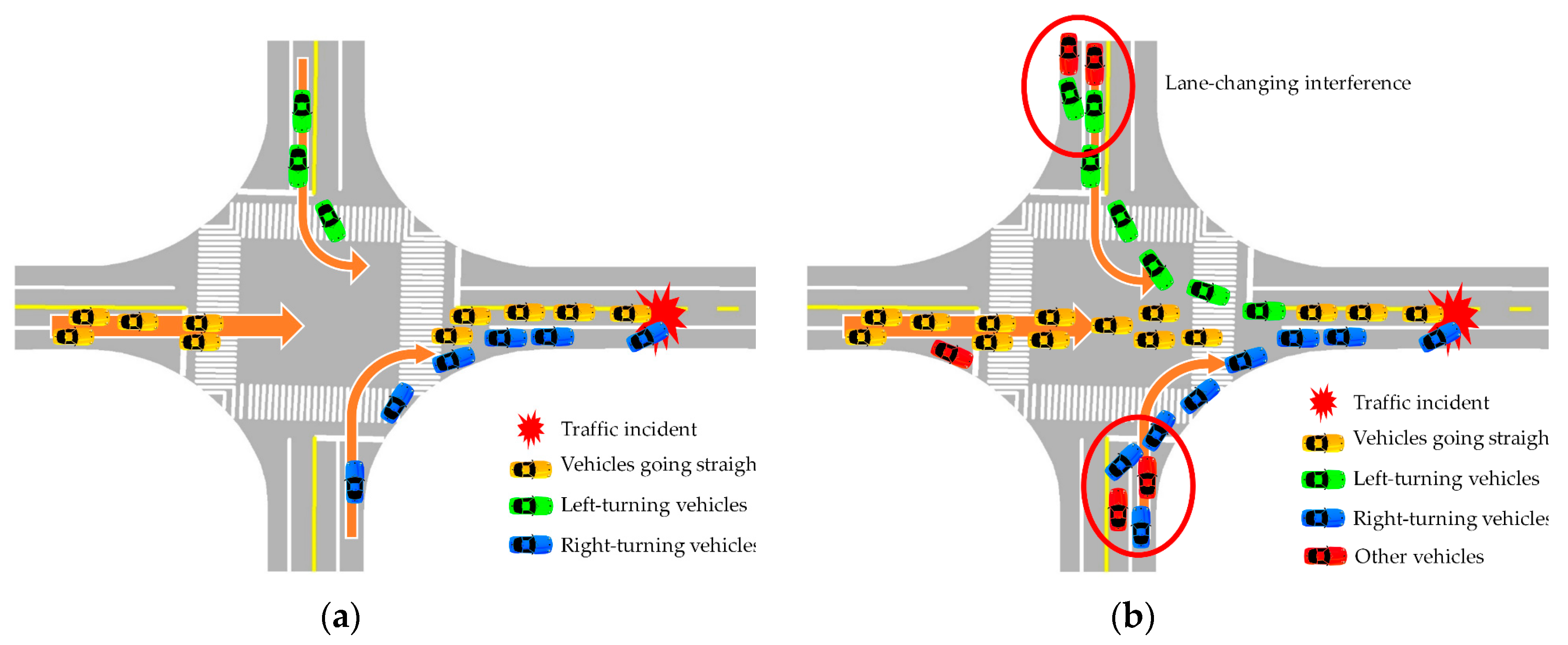
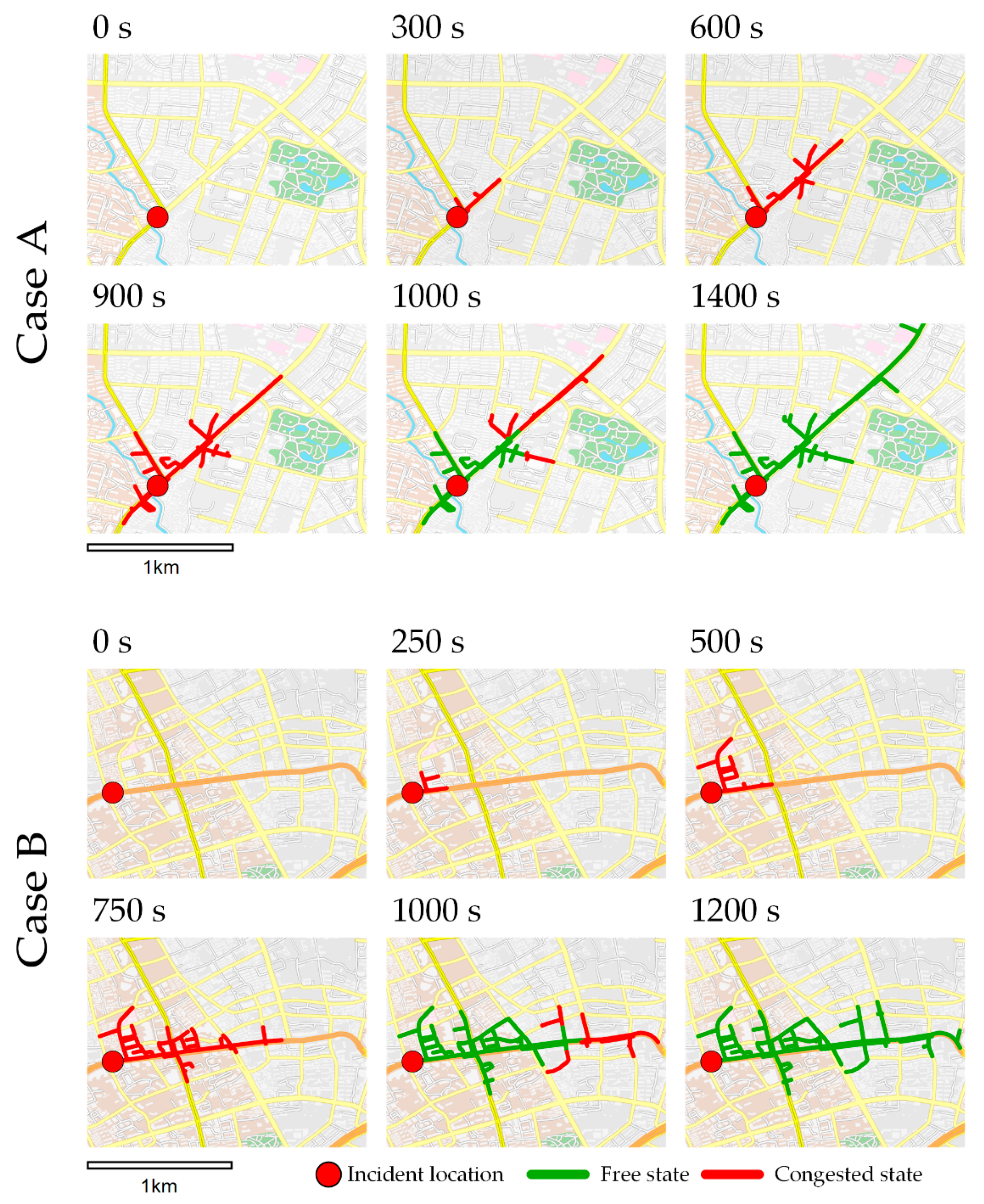
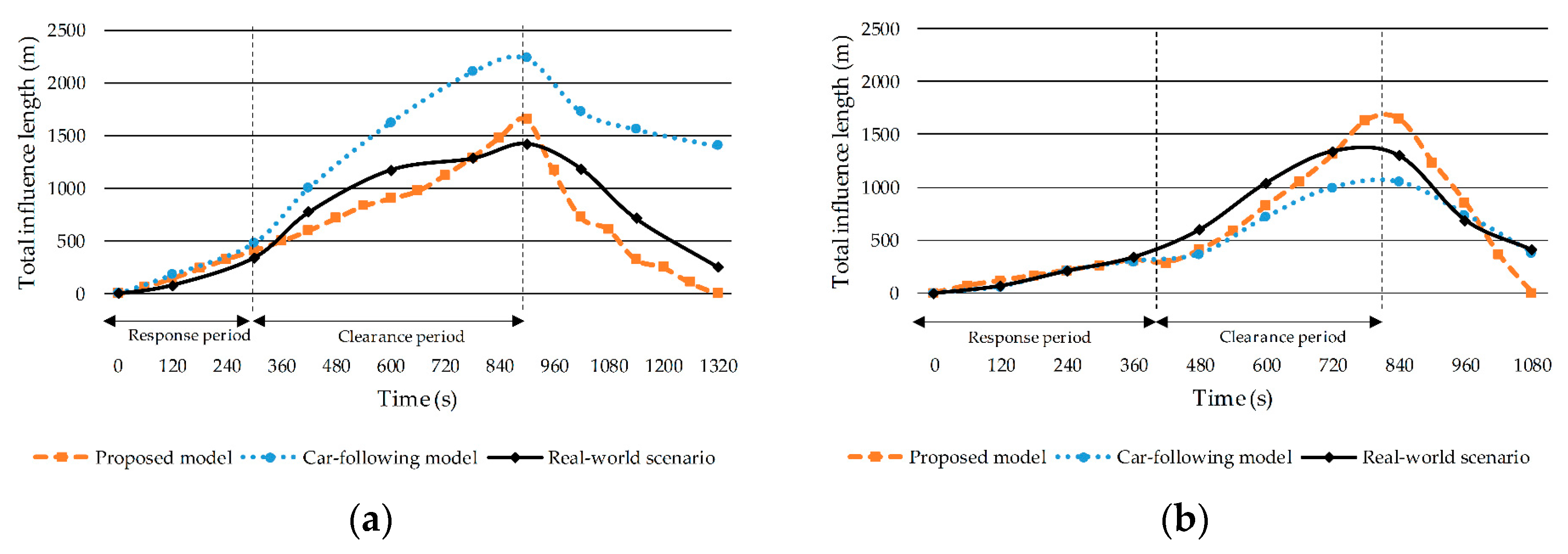
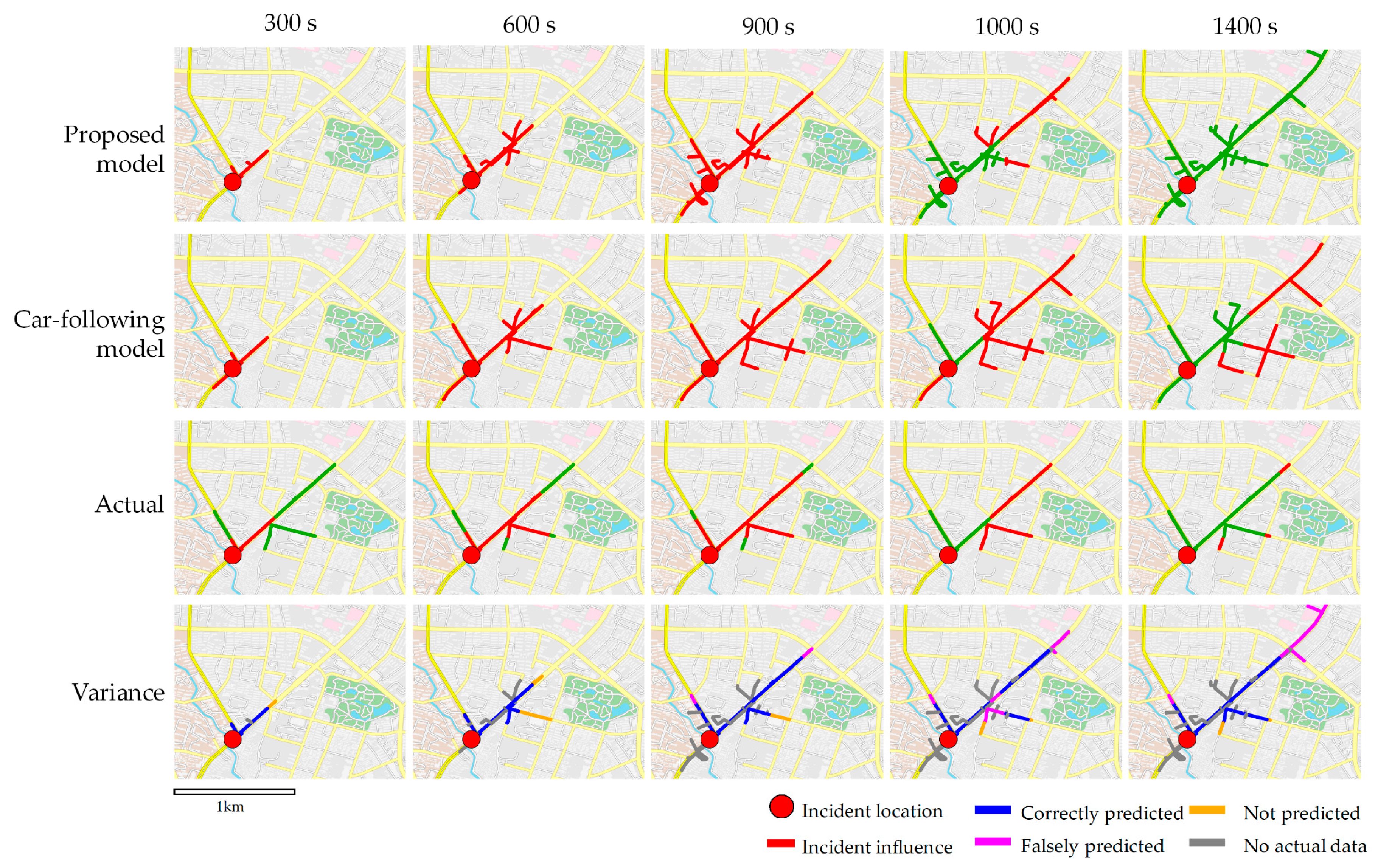
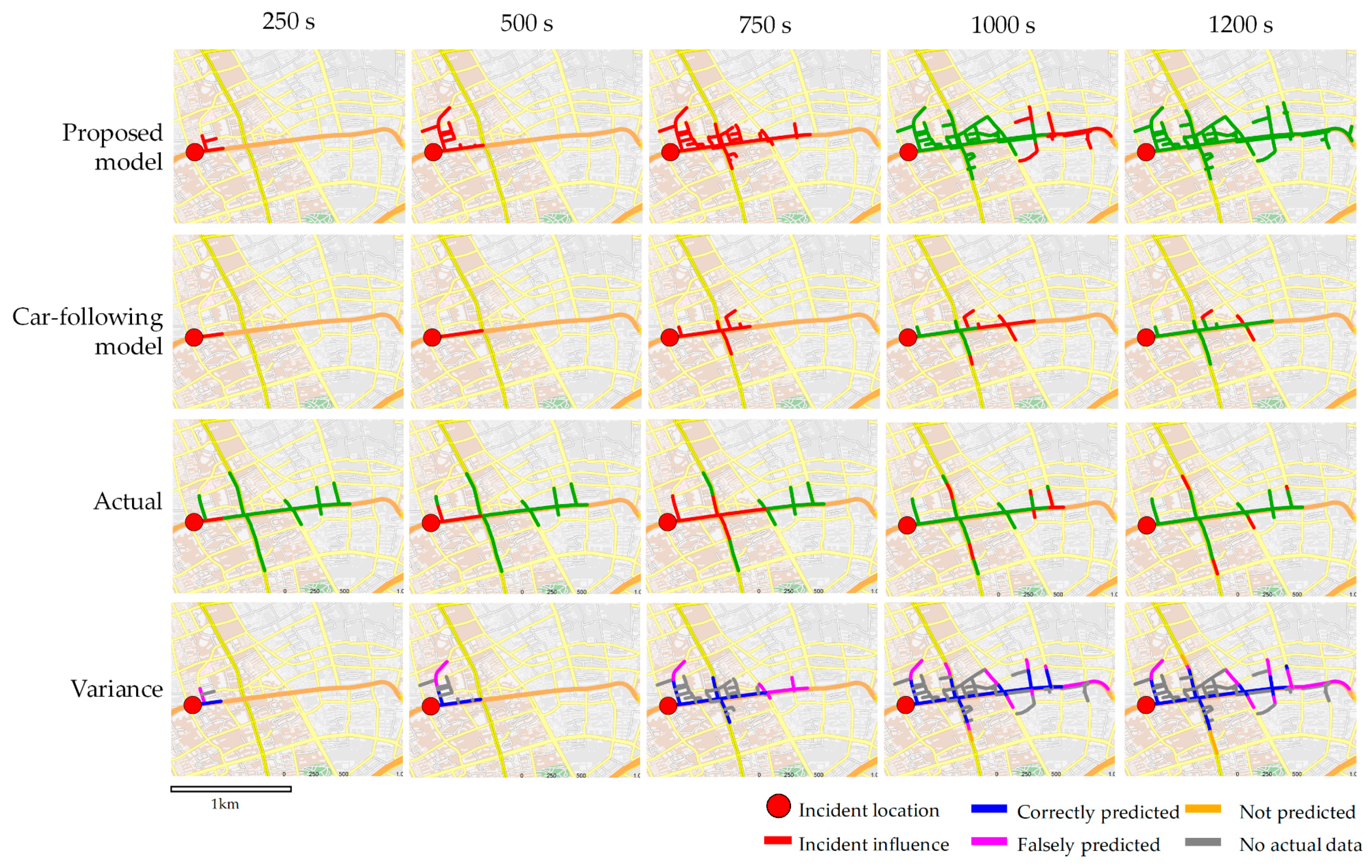
| Data Type | Parameter |
|---|---|
| Traffic incident data | Location— |
| Occurrence time— | |
| Number of lanes blocked— | |
| Response time— | |
| Clearance time— | |
| Traffic flow data | Traffic flow of each road section— |
| Road network data | Road section length— |
| Speed limit— | |
| Number of lanes— | |
| Road capacity per lane— | |
| Jam density— |
| Condition Type | ||
|---|---|---|
| Condition A1 | Upstream road | - |
| Condition B1 | - | Upstream road |
| Condition A2 | Current road | - |
| Condition B2 | - | Current road |
| Condition of Current Road | Condition of Upstream Road | |||
|---|---|---|---|---|
| Condition A1 | A1 | |||
| A2 | - | |||
| Condition B1 | A1 | |||
| B2 | - | |||
| Conditions A2 and B2 | A2, B2 | - |
| Description | Case A | Case B |
|---|---|---|
| Time | 1 July 2014 13:35 | 3 March 2014 18:22 |
| Type | Two-car collision | Two-car collision |
| Location | Siping Road, 50 m south of Quyang Road | Lujiabang Road, 35 m east of Zhaozhou Road |
| Police arrival time | 300 s | 380 s |
| Clearance time | 600 s | 410 s |
| Number of lanes blocked | 1 | 1 |
| Road hierarchy | Secondary arterial | Primary arterial |
| Number of lanes | 2 | 3 |
| Traffic capacity per lane | 650 veh/h | 900 veh/h |
| V/C ratio | 0.45 | 0.7 |
| Time | Correctly Predicted | Not Predicted | Falsely Predicted | |
|---|---|---|---|---|
| Case A | 300 s | 84.5% | 15.5% | 0.0% |
| 600 s | 74.1% | 25.9% | 0.0% | |
| 900 s | 77.6% | 6.7% | 15.7% | |
| 1000 s | 66.6% | 4.3% | 29.1% | |
| 1400 s | 61.5% | 3.6% | 34.8% | |
| Case B | 250 s | 63.3% | 0.0% | 36.7% |
| 500 s | 67.7% | 0.0% | 32.3% | |
| 750 s | 65.7% | 0.0% | 34.3% | |
| 1000 s | 64.0% | 2.1% | 33.9% | |
| 1200 s | 57.7% | 7.2% | 35.1% | |
| Model | Case A | Case B |
|---|---|---|
| Proposed model | 1.98 s | 4.78 s |
| Car-following model | 38 s | 105 s |
© 2017 by the authors. Licensee MDPI, Basel, Switzerland. This article is an open access article distributed under the terms and conditions of the Creative Commons Attribution (CC BY) license (http://creativecommons.org/licenses/by/4.0/).
Share and Cite
Liu, C.; Zhang, S.; Wu, H.; Fu, Q. A Dynamic Spatiotemporal Analysis Model for Traffic Incident Influence Prediction on Urban Road Networks. ISPRS Int. J. Geo-Inf. 2017, 6, 362. https://doi.org/10.3390/ijgi6110362
Liu C, Zhang S, Wu H, Fu Q. A Dynamic Spatiotemporal Analysis Model for Traffic Incident Influence Prediction on Urban Road Networks. ISPRS International Journal of Geo-Information. 2017; 6(11):362. https://doi.org/10.3390/ijgi6110362
Chicago/Turabian StyleLiu, Chun, Shuhang Zhang, Hangbin Wu, and Qiang Fu. 2017. "A Dynamic Spatiotemporal Analysis Model for Traffic Incident Influence Prediction on Urban Road Networks" ISPRS International Journal of Geo-Information 6, no. 11: 362. https://doi.org/10.3390/ijgi6110362
APA StyleLiu, C., Zhang, S., Wu, H., & Fu, Q. (2017). A Dynamic Spatiotemporal Analysis Model for Traffic Incident Influence Prediction on Urban Road Networks. ISPRS International Journal of Geo-Information, 6(11), 362. https://doi.org/10.3390/ijgi6110362





